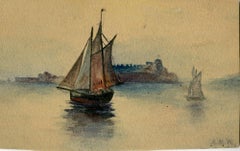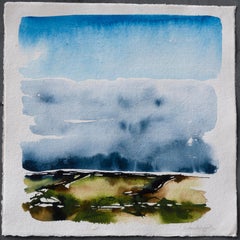Milio Burquin Art
to
1
Overall Width
to
Overall Height
to
1
1
1
1
1
1
1
1
8,228
2,806
1,654
1,315
1
Artist: Milio Burquin
French Watercolor Winter Landscape - Neige Couverte Vieux Moulin en Alsace
By Milio Burquin
Located in Houston, TX
Captivating watercolor of a charming snow covered windmill in Alsace, France by artist Milio Burquin, circa 1930. Signed lower left. Displayed on a white mat with a gold border and f...
Category
1930s Milio Burquin Art
Materials
Watercolor
Related Items
Schooners along the Hudson, West Point Academy in the distance.
Located in Middletown, NY
A serene Hudson River scene by a student of Louis Comfort Tiffany.
Anna May Walling was born in 1881, a native of Goshen, New York. She was a graduate of the Blair Academy, and Prat...
Category
Early 20th Century American Realist Milio Burquin Art
Materials
Watercolor, Handmade Paper
$350
H 3.5 in W 5.63 in
'Fall Fog Approaching'. Contemporary Landscape Clouds Moody sky Blue Green Brown
By Sophia Milligan
Located in Penzance, GB
'Fall Fog, Approaching'. Contemporary landscape painting, Cornwall
Original Artwork, Unframed
_________________
Heavy skies moving in over the autumnal landscape of West Cornwall: a ...
Category
2010s Contemporary Milio Burquin Art
Materials
Ink, Watercolor, Archival Paper
$342 Sale Price
58% Off
H 12 in W 12 in
'Ebren Ha Dor, Shifting Sky'. Contemporary Landscape, Rural, Countryside, Clouds
By Sophia Milligan
Located in Penzance, GB
'Ebren Ha Dor, Shifting Sky'. Contemporary landscape painting, Cornwall
Original Artwork, Unframed
_________________
The dancing light and rapidly changing skies, hung high above the the landscape of West Cornwall: a harshly beautiful peninsula, jutting out into the wild tireless ocean, shaped and moulded by powerful salt laden Atlantic winds. Criss-crossed by ancient, tangled hedgerows marking the stories of the leathered, labour-roughened hands worn like the granite, coloured as the bronze bracken covered land they toiled endlessly to tame, carving spaces of sanctuary against the raw elements.
A plein air painting from the series 'Ebren ha Dor' (Meaning 'Sky and Earth in Cornish). In this series, Sophia's fluid expressive style captures the immediacy of the changing light in the seasonal landscapes, whilst exploring flux and balance in the nature of all things: The freedom of the air and solidity of the soil; Of human narratives written in the wild landscapes; in the sensual interplay of light and shadow. They capture an essence of the equilibrium between wild raw energy and serene stillness; chaos and harmony; and the enduring and the effervescent.
Acrylic ink on handmade rough edge watercolour paper
Signed in pencil to the lower right corner
30 x 30cm / 12 x 12 inches
__________________________
About The Artist
Sophia Milligan is a contemporary multidisciplinary artist, exploring discourses on permanence & evanescence; the eternal, cyclical absolutes of birth & death; motherhood & childhood; and ancient immutable connections. With resonating ripples of intuition and instinct Sophia illuminates the presence of the ordinary, creating moments of sublime present.
'Born among the wild cliffs and tempestuous seas of west Cornwall, I grew with the intimate details in the twisting lanes and the intense changing light throughout the turbulent seasons. I formed a primordial connection with a deep instinctual sense of being part of the natural narrative, and wherever in the world I may be, this connectivity underpins my practice. Like the wind sculpted hawthorns and sensual coves of weather worn granite, I have been shaped by the powerful energy entwined in this ancient raw environment.’
‘We are the stories of the journeys that came before. I weave into my work the tales of transitory circumstance; of struggle and survival; of forms and textures holding records of evolutionary millennia. I paint, I draw: with marks, mixtures, photography, words; the raw earth; the restless oceans; the whispered breeze. I work with time, and the immeasurable spaces of experience within, giving subtleties of existence a pause for contemplation. There is beauty in such poignant breaths. All moments are significant, every pebble of now forms the vast mountain of yesterday, and the great realm of tomorrow's possibilities'.
Sophia has a 1st class honours Bachelor of Arts Degree in Visual Arts and World History, and a Masters Degree in Contemporary Visual Arts. Her work is held in prestigious international private collections, and exhibitions of her interactive, immersive installation, photography and mixed media works include 'Tabula Rasa', London; 'Superlative', Plymouth; 'Transition', Newlyn; The Eden Project, Cornwall; The European Parliament, Brussels; Kew Gardens, London; and 'The Cameraless Film Festival', Chicago.
_________________________________
Modern . Landscape . Contemporary . landscape . Stone . Cornwall . Sky . Yellow . Blue . Green . Brown . Rural...
Category
2010s Contemporary Milio Burquin Art
Materials
Ink, Watercolor, Handmade Paper
$673 Sale Price
19% Off
H 12 in W 12 in
Architecture Sketches Study Drawing, Romane Church in France by Maurice Lambert
Located in Atlanta, GA
Architectural Study for the Restoration of Saint-Pierre Church in Avon, France.
This unique architectural study was created as part of a church renovation project in a suburb of Pari...
Category
Late 19th Century Academic Milio Burquin Art
Materials
Ink, Watercolor, Pencil, Archival Paper
$2,850
H 27.56 in W 40.94 in D 0.82 in
Glastonbury Abbey
By Frederick Nash
Located in Middletown, NY
Ink wash with watercolor in sepia and black, and blue, on buff wove watercolor paper, 14 1/4 x 10 1/4 inches (360 x 260 mm). 1/4" of the lower right corner is lost, minor crack (doe...
Category
Mid-19th Century English School Milio Burquin Art
Materials
Ink, Watercolor, Handmade Paper
'Ebren Ha Dor, September, Softening'. Framed contemporary landscape, rural sky
By Sophia Milligan
Located in Penzance, GB
'Ebren Ha Dor, September, Softening'. Contemporary landscape painting, Cornwall
Original Artwork. Framed ready to hang
_________________
The dancing light and rapidly changing skies,...
Category
2010s Contemporary Milio Burquin Art
Materials
Ink, Handmade Paper, Watercolor
$1,121
H 17 in W 17 in D 3 in
Cottages in Devon
By Samuel Prout
Located in Middletown, NY
An early Devonshire landscape, ex-collection West Collection of British Watercolors & the Fine Art Society, London.
Circa 1800
Ink and brown wash on paper, 7 1/8 x 10 1/4 inches (...
Category
Early 1800s Realist Milio Burquin Art
Materials
Watercolor, Ink, Graphite
Rheims Cathedral
By Henri Schäfer
Located in Middletown, NY
Watercolor and gouache on cream wove paper. Signed and titled in watercolor in the lower right image area. Small circular pea-sized damp stain in the top center image area (visible in the are of the sky), and some additional small spots of unobtrusive foxing in the upper left sheet area. Otherwise in very good condition with fresh colors and intricate brushwork.
Henri Schäfer...
Category
1870s Realist Milio Burquin Art
Materials
Watercolor, Gouache, Archival Paper
Wolf, are you there #1 ? Hélène Duclos Contemporary art drawing green nature
By Hélène Duclos
Located in Paris, FR
Gouache and pencil on paper
Unique work
Hand-signed and entitled lower right by the artist
Category
2010s Contemporary Milio Burquin Art
Materials
Paper, Gouache, Pencil
$4,212
H 23.63 in W 31.5 in
Monhegan House (Fisherman’s Shack)
Located in Greenwich, CT
A classically American modernist work depicting the fisherman's shack on Monhegan Island. Great for a beach house or New England home. Along the lines of an Edward Hopper or Winslo...
Category
1950s American Modern Milio Burquin Art
Materials
Watercolor
View of Constantinople
Located in Middletown, NY
A bright and beautiful Orientalist landscape by a master of the genre.
Watercolor and graphite on cream laid paper, laid down to archival board, 14 3/4 x 6 3/4 inches (374 x 170 m...
Category
Late 19th Century Realist Milio Burquin Art
Materials
Watercolor, Graphite
Edward Duncan - Early 19th Century British watercolour drawing of a French Boat
By Edward Duncan
Located in London, GB
EDWARD DUNCAN, RWS
(1803-1882)
Boulogne Fishing Boat
Signed l.l.: E Duncan; bears title on a label on the reverse
Watercolour and pen and ink
Unframed
24.5 by 30.5 cm.; 9 ¾ by 12 in.
(mount size 31 by 37.5 cm., 12 ¼ by 14 ¾ in.)
Provenance:
Private collection.
Born in London, Duncan was apprenticed to the studio of Robert Havell, principal aquatint engraver of Audubon’s Birds of America...
Category
Mid-19th Century Realist Milio Burquin Art
Materials
Ink, Watercolor
Milio Burquin art for sale on 1stDibs.
Find a wide variety of authentic Milio Burquin art available for sale on 1stDibs. You can also browse by medium to find art by Milio Burquin in paint, watercolor and more. Not every interior allows for large Milio Burquin art, so small editions measuring 18 inches across are available. Customers who are interested in this artist might also find the work of Jane Levy, Ildebrando Urbani, and Albert Sway. Milio Burquin art prices can differ depending upon medium, time period and other attributes. On 1stDibs, the price for these items starts at $575 and tops out at $575, while the average work can sell for $575.

